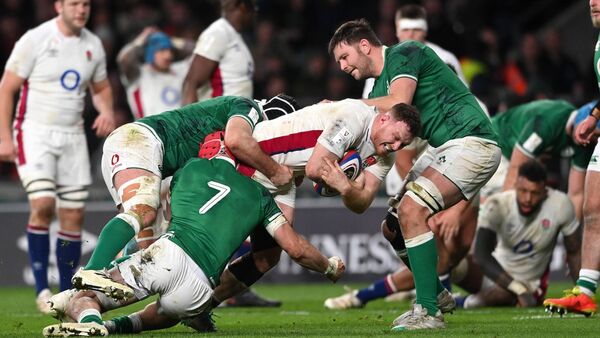The first time I heard about the Swiss cheese effect was shortly after Rob Penney arrived to coach Munster in 2012.
It’s a concept used in risk analysis which states that ‘although many layers of defence lie between hazards, there are flaws in each layer that if aligned, can allow the accident to occur’.
Rob referred to it a lot in his reviews of games. He used the term to describe situations where we compounded errors with more errors and caused things to go from bad to worse. An example of this might be knocking the ball on, then making a defensive error resulting in a line break, then giving away a penalty a couple of phases later.
These mistakes – a knock on, a missed tackle and a penalty – are not a big deal in isolation. They happen in every game and are sometimes unavoidable. However, when they happen one after another they can be catastrophic. If we go back to the definition above, the accident is your opponent scoring. The layers of defence are your defensive system, tackle technique, discipline and so on.
Each layer acts as a barrier to your opponent scoring but each layer has its flaws. When the flaws line up, the barriers disappear and the opposition can capitalise. Much of the chatter during and after Ireland’s win in Twickenham focused on the ‘heroic’ and ‘spirited’ performance of the English side.
Of course, this is fair. To lose a man in the second minute of a test match and still look like you could win with 10 minutes remaining is impressive. England played smart, effective rugby and enjoyed a level of dominance in the scrum that was surely unprecedented for a team with seven forwards on the pitch.
If we are honest though, much of the damage shipped by Ireland on Saturday was self-inflicted. It was largely caused by poor discipline and in particular, repeated examples of the Swiss cheese effect in action.
All five of England’s scores came directly as a result of two or more Irish errors in quick succession. Four of these sequences began with Ireland deep in English territory.
England didn’t have to create much themselves because Ireland were creating the opportunities for them.
The match statistics paint a stark illustration of this. England only carried the ball 54 times and threw 68 passes.
To put those figures in context, Ireland made 141 carries and Jamison Gibson-Park threw 59 passes on his own.
Despite having a stranglehold on possession throughout the game, Ireland’s lack of composure meant England could keep casting the fishing line and reeling them in. Take Marcus Smith’s first penalty for example. Following Gary Ringrose’s knock on at the base of the ruck and Caelan Doris’ disallowed try, England have a scrum on their own five metre line in the 13th minute. They win a huge penalty and exit the danger zone. At the lineout, Ireland give away a free kick.
Smith kicks an up and under. Hugo Keenan gathers and takes contact and two phases later, Tadhg Beirne throws a pass on the deck, creating messy ball. Still, Ireland recover well and manage to get the ball to the space out wide, only for James Lowe to get penalised for holding on in the ruck. That’s two penalties, a free kick and a pass on the deck in the space of 90 seconds. Classic Swiss cheese.
England kick to touch again and while Ireland do well to get a hand on the lineout throw, it goes forward and England win another scrum penalty in front of the posts. Three penalties and a free kick in a calamitous four minutes that sees Ireland go from the English five metre line to watching the ball sail over their own posts.
England’s second score has a similar story. It begins with an attacking Irish lineout just outside the English 22. Josh van der Flier gets turned over in the maul after great work from Maro Itoje and England are awarded a scrum, where they win a penalty. Iain Henderson gives away another soft penalty at the lineout which follows. That’s a turnover and two penalties in three set pieces, one after the other.
Again, Ireland have gone from a brilliant attacking position to giving Smith a shot at goal. He misses this time and Ireland skillfully regather their own 22 metre dropout. It’s only a brief reprieve, as Gibson-Park fails to retreat when Ringrose grubbers downfield and a penalty is awarded. Smith makes no mistake this time.
That amounts to nine different mistakes in the lead up to two English scores. You could not count scrum penalties as unforced errors but even leaving them out, six of the mistakes were. Against a side of that quality you simply cannot do that, whether they have 14 or 15 men on the pitch. What epitomised Ireland’s ‘shoot ourselves in the foot’ day more than anything was Smith’s third penalty on the stroke of half time.
Having scored an excellent try through Hugo Keenan to take a nine point lead, Ireland failed to claim the kick off and shortly thereafter gave away another penalty in front of the posts, which Smith slotted. Once again, England didn’t have to do anything themselves. Ireland did the hard work by grinding out a score, only to hand the initiative straight back to England. It’s like closing all the windows of an enormous house and setting the alarm but leaving the front door wide open.
As to why this kept happening, it is hard to say. The lazy answer which you will probably have heard by now is that Ireland simply ‘switched off’ when Charlie Ewels was sent off. There might be some truth to this but these Irish players do not just switch off in front of a full house in Twickenham because their opponents lost a man to a red card.
If anything, the opposite may have been the case. It struck me that Ireland were trying to play the game at too frantic a pace for their own good. They were so preoccupied with making the advantage pay that they were thinking one or two phases ahead and trying to make everything happen immediately.
They got caught up in the bigger picture and as a result, neglected the basics at times – things like not infringing at the lineout, supporting the ball carrier at the breakdown and making sure the pass was going to hand.
On many occasions, they tried to force things in attack and it cost them. Ireland already had more handling errors than anyone else in the tournament prior to last weekend and they added another 14 to that number on Saturday.
The most frustrating Swiss cheese sequence started with forcing things in attack in the 48th minute. After a period of sustained pressure, Tadhg Furlong lost the ball forward as he tried to offload to Bundee Aki five metres from the English line. After winning another penalty at the scrum, England kicked to touch and a few phases later, Smith kicked an up and under.
Keenan’s teammates failed to support him properly when he plucked it out of the sky, allowing Joe Marchant to get his hands on the ball and win a penalty. In two minutes, Ireland once again went from looking certain to score to conceding three points; three errors sending them 65 metres back down the pitch.
As expected, Ireland turned the screw enough and England ran out of steam. We will always rejoice at a bonus point win in Twickenham. Ireland stuttered on their way to this win however, and while the scrum will be the focus of many in the media this week, it is simplistic to credit the English scrum alone with keeping them in the game.
Of far more concern to me is the compounding of errors that we saw and the number of times the Swiss cheese effect set in. England’s five converted penalties came directly from 17 Irish errors. Of these 17 errors, 11 could be considered unforced. Any team with a decent kicker will find it easy to hang on against a better side, if the better side keeps handing them opportunities to move down the field and kick at goal. With one eye on next year’s World Cup in France, it’s not something we want to see a repeat of, against Scotland or anyone else.

